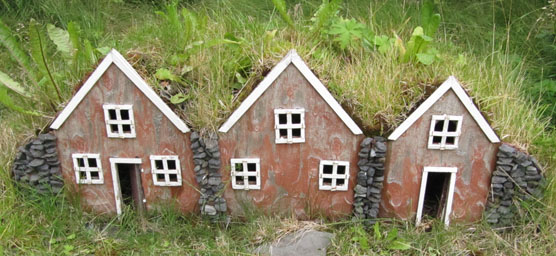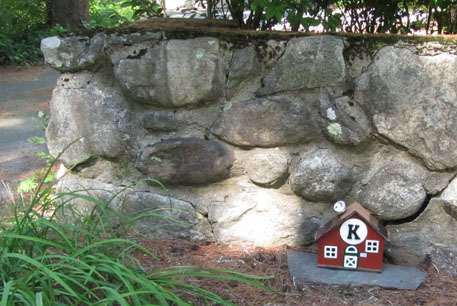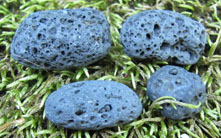 It's widely reported that Icelanders believe in the existence of elves. The percentage of believers varies in different reports - I've found numbers between 25% and 80% on the web. The picture below shows some elf houses set into the sod at the Folk Museum in Skógar, which we visited on our recent trip to Iceland. They're only about 30 cm. high (1 foot). Note 1  We bought a book in Iceland called The Hidden People Of Iceland, by Brian Pilkington and Terry Gunnell. It distinguishes between various types of hidden people, some of whom are the same size as ordinary people, while others, the elves, are much smaller. All, however, are invisible. The general term in Icelandic is huldufólk. As for the origin of the hidden people, the book states that, "The most well-known legend suggests that the first huldufólk were children of Adam and Eve and lived alongside Cain and Abel. According to the story, which is also told about close relations of the huldufólk in the other Nordic countries, problems began when Eve suddenly received a surprise visit from God one day. He wanted to see how things were progressing with her and Adam. At the time, Eve was in the process of washing her children, but hadn't finished the job. Apparently, she was ashamed to show God those children that she had not washed the dirt off. God then punished Eve for her shame by hiding the unwashed children away from everyday view for eternity. This is why they came to be known by the Icelandic as the huldufólk." Note 2 It struck me that the Icelanders are a people with vivid imaginations. Or at least a people who are willing to lie to pollsters. But when you come right down to it, when you are part of a small population living atop multiple highly active volcanoes, in a place where it's dark most of the day during the winter, a sense of humor must be a necessity. We picked up the publication, What's On in Reykjavík, August 2014, and found it to contain a few pages called "Practical Information and FAQ". These included the question, "WHAT ABOUT TROLLS AND ELVES AND STUFF? SHOULD I WORRY?" The answer is "Nah, not really. Unless you provoke or irritate them, in that case you should run." Then again, the start of the answer to the question, "IS IT SAFE FOR ME TO DRIVE IN ICELAND?" is "Unless you're a complete asshole - driving should be quite safe." You can see the entire FAQ on the What's On web page - click on "FAQ" on the bar at the top. It's worth reading. As I said, Iceland has a sense of humor. Indeed, they need it. Within the past few days, an article in Slate.com has reported that, "An intense earthquake swarm began Saturday deep beneath Bárðarbunga, Iceland’s largest volcano complex", adding, "... on Monday the Icelandic Met Office raised its aviation color code for Bárðarbunga to orange to signify a 'heightened or escalating unrest with increased potential of eruption'." This is the volcano under the Vatnajökull glacier, the largest glacier in Europe. An ash eruption there could make the 2010 eruption of Eyjafjallajökull seem like child's play. The Boston area, where we live, has had some nasty snowfalls. We've also had a few minor earthquakes, although I slept through all of them. We've had hurricanes, and even a few tornadoes. But we've never had an "intense earthquake swarm", let alone a volcanic eruption. The home page of the Icelandic Met Office ("Met" = Meteorological) looks like the sort of weather site one might find in the United States. But click on the Seismicity tab, and a world opens up about events that don't normally concern us here: earthquakes and magma and ash, oh my!. As of the posting of this entry on August 21, 2014, the Met Office is reporting, "Intense earthquake swarm continues at Barþarbunga. Presently there are no signs of magma moving to the surface".
You can learn more about Iceland's elves on my daughter Sara's blog entry entitled Magical Iceland: Underground Rivers, Fires, and Elves. Another entry, Living Under a Volcano, covers our visit to the Folk Museum in Skógar. Sara accompanied us on our trip, and she took a lot more pictures than I did. If you go to the Iceland category of her blog, you can learn much more about our trip than I'm going to post in my own blog.
In the picture, L-R: back row, Tryggve and his wife Birta. Front row, their children Urþar and Eydís. Hidden in the rocks, of course. Below, the house we built them, which can be seen in front of our stone wall, near our driveway. Click on the image for a closer look at the house.  We also painted it for them. Boy, were they picky about the colors. And as you can see by the satellite dish, we've gotten them a subscription to DirecTV. They've also got Internet. Actually, the only way we can communicate with them is via e-mail, using the elf seer in Reykjavík as an intermediary. The address of our house is 15, so the address of their house is 15A. Or perhaps the A stands for álfur, the Icelandic word for elf. Note 3 We're happy to help out a family of Icelandic elves. It's only a small house, so it's only got a small mortgage.   Note 1: Here's an article that shows a large rock that needed to be moved before building a highway, because it was alleged to contain an elf church. The elves are often said to be hiding out in rocks. You might also take a look at the Wikipedia page on the Icelandic Elf School. [return to text] Note 2: Another account suggests that the huldufólk are the children of a less obedient wife of Adam, named Lilith, who supposedly preceded Eve. Yet a third story suggests that the original huldufólk were fallen Angels. [return to text] Note 3: The root of the Icelandic word for "elf", álfur, is obviously álf - it's essentially the same as the English word, with only a small vowel shift. The "ur" at the end is a case ending. If you want to learn much more than you really need to know about case endings in German, see my blog entry on German article and adjectival inflections (warning: it's a killer). Icelandic, a north-Germanic language, has even more complex noun declensions than German (German and English are west-Germanic). [return to text]  |

